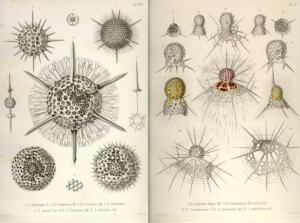Radiolarians
Radiolarians (also radiolaria) are amoeboid protozoa that produce intricate mineral skeletons, typically with a central capsule dividing the cell into inner and outer portions, called endoplasm and ectoplasm. They are found as zooplankton throughout the ocean, and their skeletal remains cover large portions of the ocean bottom as radiolarian ooze. Due to their rapid turn-over of species, they represent an important diagnostic fossil found from the Cambrian onwards.
Radiolarians have many needle-like pseudopodia supported by bundles of microtubules, called axopods, which aid in the Radiolarian's buoyancy. The nuclei and most other organelles are in the endoplasm, while the ectoplasm is filled with frothy vacuoles and lipid droplets, keeping them buoyant. Often it also contains symbiotic algae, especially zooxanthellae, which provide most of the cell's energy. Some of this organization is found among the heliozoa, but those lack central capsules and only produce simple scales and spines.
Some radiolarians are known for their resemblance to regular polyhedra, such as with the icosahedron-shaped Circogonia icosahedra pictured to the left.
See: http://en.wikipedia.org/wiki/Radiolaria In the Virtual Museum there are total 2 samples | ||
Virtual museum of the Czech Geological Survey, www.geology.cz, (C) Czech Geological Survey, 2011, v.0.99 [13.12.2011]


![[ENG]](img/vlajka-cr.gif) Česky
Česky 



